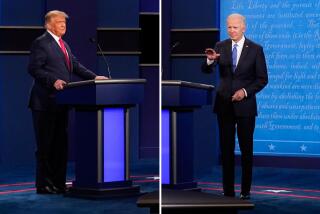Networks Agree to Monitor for Violence on TV Shows : Media: Accord precedes congressional debate and follows similar cable plan. But broadcasters eschew calls for rating system and program blocking.
- Share via
WASHINGTON — The four broadcast networks Friday reached an agreement in principle to use an independent monitor to review their programming for violent content.
The agreement comes just days before Congress returns with the regulation of television violence high on its agenda and just as the major cable networks have agreed to use such a system.
The cable agreement was contained in an 11-point plan that also calls for the development of a violence rating system and endorses technology that would allow viewers to block programs rated as violent from their television sets.
The networks have been unwilling to support the latter two initiatives because they believe in part that such moves would cause advertiser defections.
The network accord, which was finalized in a conference call Friday by executives of NBC, CBS, ABC and Fox, still must be approved by the heads of the networks. That approval is expected in the next few days, and a formal announcement is likely early next week.
Decisions as to who will run the system, how that person (or organization) will be chosen and to whom he will report are still to be worked out. It is unlikely, however, that the networks will employ the same monitor as the cable industry.
In addition, sources say the monitoring system will be a “qualitative rather than quantitative” assessment of network programming. In a quantitative assessment, actions that are deemed violent are simply tabulated without regard to context, which means that cartoons and cop shows are given equal weight.
The effectiveness of the monitoring system is believed to rest on the fact that annual reports will be made public and that the threat of negative reactions from advertisers and the public is expected to keep the networks in line.
Network executives are likely to present the plan early next week to Sen. Paul Simon (D-Ill.), who has been pushing for such a monitor system.
Simon, reacting earlier Friday to both the cable initiative and the likelihood of the broadcasters’ agreement, said he believed such action would alleviate the pressure for legislation to regulate TV violence.
He said, however, that he would prefer that cable and the broadcasters use the same monitor to ensure a consistent approach.
Rep. Edward J. Markey (D-Mass.), who introduced legislation on the so-called V-chip, the technology that would enable viewers to block certain programming, said Friday that he believed legislation would be inevitable if the broadcast networks did not join the cable industry in approving the technology and a rating system.
“It’s all about advertising,” Markey said. “That’s what this whole debate boils down to . . . Violence sells.”
He said of the V-chip: “Even if a small percentage of parents used the technology, the networks will see declining ratings for violent programs. The result will be less violence on television.”
Still, the acceptance of a monitoring system is a major step for the four networks, which have resisted it for months, saying their own standards and practices operations are doing the job.
Broadcasters have debated fiercely among themselves over whether a monitoring system would decrease the likelihood of legislation. ABC and CBS have been more receptive to the idea, with NBC and Fox more resistant.
Since summer the networks have been taking any steps they thought would help ward off congressional action. They believed then that they had satisfied lawmakers’ push for action when they agreed to air parental advisories before shows with violent content. It was their understanding, spokesmen say, that Simon would then give them two years to let the advisories work and see what other action they took before pursuing further congressional inquiry.
But Susan Kaplan, an attorney on Simon’s staff overseeing television violence issues, said: “I never heard him say that, and I know that wasn’t his view.”
Simon on Friday termed this week’s initiatives “a significant shift.” He said he believed the monitoring system would ensure that network programmers continue to show less violence on the air.
He said the V-chip was “not something that in my opinion is essential,” adding that the V-chip is “not a substitute for reducing violence on television.”
The tensions between the four networks and the cable industry were reflected to some degree in network reaction Friday to the cable plan for regulating violence.
For example, Julie Hoover, ABC’s vice president of corporate communications, said: “We are delighted that the cable industry has adopted some of the things we have been doing,” referring to ABC’s Department of Broadcast Standards and Practices, as well as to the network’s scheduling of programs. “Virtually all our programs are rated G.”
More to Read
The biggest entertainment stories
Get our big stories about Hollywood, film, television, music, arts, culture and more right in your inbox as soon as they publish.
You may occasionally receive promotional content from the Los Angeles Times.










